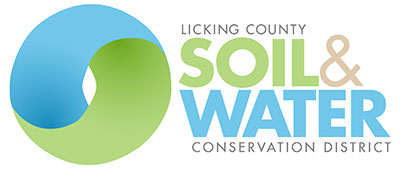Since 1944, Licking County Soil & Water Conservation District exists to promote wise use of our land and water. During those 75 years, Licking Soil & Water has worked with countless landowners to manage and protect natural resources on public and private lands. This year, for our 75th birthday, Licking Soil & Water is reflecting on our history in and impact on Licking County. Below is Part One of a four-part series celebrating our legacy.
Do you remember reading John Steinbeck’s The Grapes of Wrath? Those “Okies” were leaving Oklahoma after drought, the Great Depression of the 1930s, and collapse of the tenant farmers’ agriculture system. The soil was destroyed to the point of blowing away; this phenomenon was called the Dust Bowl. On May 12, 1934, the worst dust storm in the nation's history swept eastward from the Great Plains to the Atlantic Ocean, obscuring the sun and depositing obvious films of dust as it moved. This catastrophic storm served as the catalyst for public outcry and congressional action for soil and water conservation throughout the nation.
Why did the Dust Bowl happen? Could it be prevented? What can we learn from these mistakes? The federal government tried to answer these questions through the creation of the Soil Conservation Service (SCS) within the US Department of Agriculture (USDA) in 1935. A man named Hugh Hammond Bennett led the fledgling SCS but was not new to soil science. Bennett was convinced that soil was not an exhaustible resource and had been working feverishly to share his opinions with colleagues and land managers since the early 1900s. He co-wrote Soil Erosion: A National Menace in 1928. Over the course of his 16 years with the SCS, Bennett changed the mindset of farmers and politicians toward soil and its conservation practices.
Unfortunately and not surprisingly, the farmers that SCS wanted to work with in 1935 were skeptical of federal involvement. Not much progress was made until the federal government enacted a law establishing a state soil conservation agency and most-importantly, procedures to organize local soil and water conservation districts. In 1941, Ohio created the Ohio Soil Conservation District Enabling Act so local conservation districts could begin to rebuild soil in partnership with the agriculture community.
In 1943, a group of 75 Licking County landowners requested a hearing and petitioned the state for the formation of a local conservation district. Once the Ohio Soil Conservation Committee deemed there to be a sufficient need for the district, the petitioners conducted a local referendum for or against the proposed conservation district. The referendum’s overwhelming support indicated that local people were dedicated to the cause of soil conservation and spoke emphatically at the polls when given the opportunity. Five Supervisors were elected and the Licking County Soil & Water Conservation District officially became a political subdivision of the State of Ohio. E. T. Denman, J. F. Morrison, Clayton Oyler, George Smith, and H. Lee Williams served as the first Board of Supervisors.
Ohio did not suffer from wind erosion like the American Great Plains did during the Dust Bowl, but we did suffer soil damage via water erosion. The solutions, and the processes to adopt and install those solutions, were painful to accept and took courage by all involved. Licking Soil & Water employees and elected Supervisors, as well as farmers served as local conservation professionals who understood local resource issues. The locally-led component of the soil and water conservation district model literally transformed agricultural practices in Licking County.
To reduce soil loss via water erosion, farmers were asked to voluntarily leave crop residue on their fields, to plant with the contours of the land, to build terraces to slow down surface water runoff, and to turn the most fragile areas back to their natural state. To encourage and reward conservation farming, the USDA provided cost-sharing payments for conservation practices.
Our big day came when The Second Frontier demonstration took place near Brownsville on October 2, 1947. Licking County Soil & Water Conservation District Chairman J. F. Morrison hatched the idea with Farm Planner Morton Hamilton, Bill Diehl of the Newark Advocate, and USDA District Conservationist Pearl Fogle. Their idea was to convert an entire farm to conservation methods in one day. John Rodman’s farm and George Latham’s farm outside of Brownsville had a natural amphitheater and was particularly accessible right on Route 40. The location could easily host a demonstration by farmers for farmers and the land was ripe for conservation improvements. Donations for equipment and of volunteer time from community members to coordinate the massive field day were overwhelming.
In advance of Second Frontier Day, SCS created a whole-farm conservation plan that classified what land uses were suitable for various soil types on the property. On October 2nd, land was tiled to improve drainage, terraced to slow down water runoff, and strip-cropped along the contours of the land and alternating between wheat and grass to slow and filter runoff. Land was plowed, disked and fertilized. A water storage reservoir was built and twelve acres of trees were planted. Some fences were taken out and more fencing was installed to follow the land’s natural contours.
Over 100,000 spectators were expected and the program of events was impressive. Louis Bromfield, Ohio Governor Thomas J. Herbert, SCS State Conservationist T. C. Kennard, U. S. Senator John W. Bricker, Ohio Federation of Soil and Water Conservation Districts President Clay Stackhouse, and the legendary SCS Chief Dr. Hugh Hammond Bennett were present to offer their messages of support and expertise.
According to Robert Waldrop, a radio personality from WTAM out of Cleveland, “There is only one word that can describe the Second Frontier demonstration…American. It’s the American way of calling attention to an American need. It can all be summed up in a few words…poor land – poor people --- good land –strong people”.
Although over seventy years have passed since Second Frontier Day, you can still see the conservation practices from US 40. The Second Frontier Memorial Plaque in Honor of Hugh Hammond Bennett is on display at the Licking Soil & Water office in Newark.
Sources include:
Ohio Department of Agriculture - https://agri.ohio.gov/wps/portal/gov/oda/divisions/soil-and-water-conservation/local-swcd-resources/
The Times-Gazette - https://www.timesgazette.com/news/14097/highland-county-had-ohios-first-conservation-district
Licking County Records and Archives - https://www.lcounty.com/depts/records_n_archives/
Ohio Genealogical Society - https://www.ogsarchive.org/files/original/6171200c9e5e586f2fee6ace0a8ee55d.pdf



